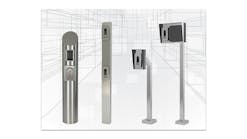In most states, the adopted building codes and fire codes are based on model codes created by the International Code Council (ICC) or the National Fire Protection Association (NFPA). The model codes and many of the referenced standards are updated on a three-year cycle, and states may adopt the new editions at any time. These adoptions often include state modifications to address local conditions.
The 2021 model codes are out, and some states soon will begin the process of implementing changes that were made in the new editions. Although it might take some time for the new model codes to be adopted in all jurisdictions, it’s important to know what to expect. Some of the approved modifications are more like clarifications and might be helpful immediately in communicating the intent of the code requirements.
The Builders Hardware Manufacturers Association (BHMA) has a committee focused on the code-development process. The Codes, Government, and Industry Affairs Committee ensures that the door and hardware industry is represented. During each code-development cycle, the committee submits dozens of change proposals, as well as monitors and shapes changes proposed by other organizations and individuals. Changes are aimed at addressing new technologies or recently identified threats, or clarifying requirements for more-consistent interpretations in the field.
Several of the changes made to the 2021 model codes affect the sections related to locks and latches. The summaries of these changes below refer to two model codes — the International Building Code (IBC) and NFPA 101 – Life Safety Code — but other publications in these families of codes include similar requirements.
One Motion to Unlatch
For doors in most locations, the model codes require one releasing operation to unlatch the door (all latches simultaneously). In the 2021 editions of the model codes, the word “operation” was changed to “motion” to clarify the intent. Turning a lever or thumbturn, pushing a paddle or pushing a touchpad would be one motion and must unlatch the door, with a few exceptions. Entrance doors to residential dwelling units and sleeping units (for example, apartments and hotel rooms) that have an occupant load of 10 people or less may have a nightlatch, deadbolt or security chain in addition to the latching hardware. The hardware must not require a key to release it on the egress side and must not require simultaneous operation of the two locking devices. This application is an example of a location where two releasing motions may be used to unlatch the door.
Beginning with the 2018 edition, NFPA 101 added another location where two releasing motions are acceptable, and this change was carried forward in the 2021 edition. NFPA 101 allows two nonsimultaneous releasing operations to unlatch existing classroom doors, if the door hardware meets all of the other requirements stated in the code. The lock must be capable of being engaged without opening the door, and the door must be capable of unlocking or unlatching from the classroom side without a key, tool, special knowledge or effort.
The operable hardware must be located between 34 inches and 48 inches above the finished floor, and the door must be able to be unlocked from the outside with a key or other credential (refer to NFPA 101 for additional requirements). Note that the IBC and IFC require one motion to unlatch classroom doors, so the second releasing operation is allowed only on existing classroom doors in jurisdictions where the 2018 or 2021 edition of NFPA 101 has been adopted.
Operable Force for Hardware
The 2010 Americans with Disabilities Act Standards for Accessible Design introduced a requirement for the force to operate door hardware, limiting the operable force to 5 pounds. This change was made without resolving conflicts in other codes and standards, so it has created problems in the field with interpretations and enforcement.
In addition to the ADA standards, another accessibility standard that’s used widely in the United States is ICC A117.1 – Accessible and Usable Buildings and Facilities. This standard is referenced by the model codes and is used during design and construction. Until the 2017 edition, A117.1 didn’t include a limitation on the operable force for door hardware, but a change was made to address the issue. The maximum force to operate hardware with a pushing or pulling motion, such as panic hardware, is 15 pounds. For hardware that’s operated by a rotational motion, such as a lever handle, the limit is 28 inch-pounds.
Prior to the 2021 edition of the IBC, the code limited operable force to 15 pounds to release the latching hardware on a door, but in the 2021 edition, the operable force has been made consistent with ICC A117.1. The conflict with the 5-pound limit in the 2010 ADA standards remains, and this must be resolved by the Authority Having Jurisdiction (AHJ).
Egress from Exterior Spaces
One security problem that arises often is the question of how to secure exterior spaces, such as courtyards and roof terraces, when the path of egress from the exterior space passes through the interior of a building. Allowing egress through the building also could allow unauthorized access to the building interior. Past editions of the model codes didn’t include an allowable method for securing these doors.
A change was made to the 2021 IBC that addresses egress doors serving exterior spaces that have an occupant load of 300 people or less, allowing the doors to be secured on the exterior side if certain criteria were met. The lock must be of a type that’s readily distinguishable as locked (for example, an indicator deadbolt), and the door must have signage that states: THIS DOOR TO REMAIN UNLOCKED WHEN THE OUTDOOR AREA IS OCCUPIED. Adjacent to at least one exit access door serving the exterior area, there must be a weatherproof phone or two-way communication device, with signage describing how the system is used. In addition, a clear window, sidelight or vision light at least 5 square feet in area must be provided at each of the exit access doors. With these measures in place, an exterior area can be secured safely.
Doors Serving Balconies
The change that addresses egress doors serving exterior spaces also includes requirements for doors serving individual balconies. Prior editions of the model codes were silent on egress provisions for balconies for residential dwelling units and sleeping units, or for private offices. Although these doors often include locking hardware to prevent unauthorized access from the balcony to an apartment, hotel room or office, some AHJs interpreted the codes in a way that required free egress from the balcony into the building.
The change to the 2021 IBC allows these balcony doors to be secured to prevent access from the balcony to the interior of the building. Securing the door on the interior side to prevent access to the balcony also is acceptable as long as the balcony isn’t part of a means of egress. The new section addresses individual balconies to residential dwelling units and sleeping units, as well as balconies for private office space where the exterior area is 250 square feet or less. The requirements that apply to the larger exterior spaces addressed in the section above don’t apply — the lock indicator, signage, telephone and vision panel aren’t required by code for individual balconies.
Mechanical Locking in Health-Care Facilities
Two types of locking systems for health-care facilities are addressed in the model codes — electrical systems and mechanical locks. The electrical locking system commonly is called “controlled egress” and has been allowed by the I-Codes and the NFPA codes since the 2009 editions.
This type of system typically requires fail-safe locks that secure the door on the egress side indefinitely but allow egress via automatic release methods or staff assistance when evacuation is necessary. Controlled-egress locks have become fairly common for memory-care facilities, infant nurseries and other locations where the clinical needs of the patients require containment for their safety or security.
NFPA 101 included a section that allows mechanical locks on some types of health-care units, and the 2021 edition of the IBC also will include a section addressing this application. Where patients require containment for their safety or security, the IBC now allows mechanical locks in Group I-1 Condition 2 and Group I-2 occupancies, as long as all clinical staff can readily unlock the doors at all times. Staff must have the keys, codes or other means necessary to facilitate egress.
There is limited information in the model codes for facility managers and code officials to use as guidance regarding the installation of mechanical locks preventing egress vs. electrified controlled-egress locks. Fail-safe electrified locks have many safety overrides and likely would allow staff to evacuate patients more quickly — unlocking each mechanical lock individually could delay evacuation during a fire. It remains to be seen how this will be applied or enforced in the field.
Further Changes
Additional changes have been made in the 2021 model codes, including those related to fire-door labels, terminated stops, maximum width of an egress door, panic hardware on electrical equipment rooms and refrigeration machinery rooms, mounting height of hardware on doors and gates serving swimming pools, restroom privacy sets and the use of key-operated locks on entrance doors. In NFPA 101-2021, the Chapter 7 section titled “Locks, Latches, and Alarm Devices” has been reorganized, including the sections addressing Special Locking Arrangements.
Some of these modifications are clarifications and can be used right away to help ensure consistent interpretation of the codes. Others are actual changes to the codes that won’t apply until the 2021 editions have been adopted in a project’s jurisdiction. In many cases, there are state or local modifications to the codes that vary from the model code requirements. For more information, consult the adopted code or the AHJ.
Lori Greene, DAHC/CDC, CCPR, FDAI, FDHI, is manager, codes and resources at Allegion. Visit her website, idighardware.com.

Lori Greene, DAHC/CDC, CCPR, FDAI, FDHI
Lori Greene, DAHC/CDC, CCPR, FDAI, FDHI, is manager, codes and resources at Allegion. Visit her website, idighardware.com.






